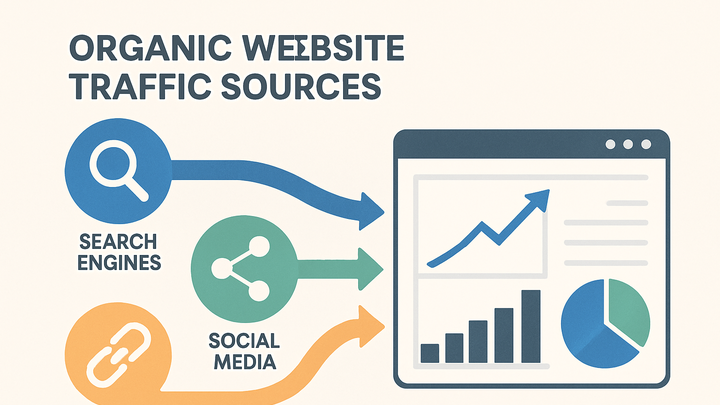Published on 2025-06-22T04:13:22Z
What is Organic Traffic? Definition and Examples in Analytics
Organic traffic refers to website visitors who arrive through unpaid channels such as search engines, social media shares, and referrals. In the analytics industry, tracking organic traffic is essential for understanding genuine user interest and measuring the effectiveness of SEO, content marketing, and link-building efforts. Organic traffic often leads to higher engagement and lower acquisition costs compared to paid traffic, making it a key performance indicator for sustainable growth. Tools like Google Analytics 4 (GA4) and PlainSignal (a cookie-free analytics solution) automatically classify and report organic sessions. By analyzing organic traffic data, businesses can identify trends, optimize marketing strategies, and improve ROI over time.
Organic traffic
Unpaid website visitors from search engines, social media, and referrals tracked in analytics tools like GA4 and PlainSignal.
Overview of Organic Traffic
An introduction to what organic traffic is and why it matters for digital analytics and marketing strategies.
-
Definition of organic traffic
Organic traffic refers to visitors who find your website through unpaid methods, such as natural search results, social media shares, and backlinks from other sites.
-
Importance of organic traffic
Because it is unpaid, organic traffic often reflects genuine user interest and intent, leading to higher engagement, better trust signals, and a lower cost per acquisition compared to paid channels.
Tracking Organic Traffic in Analytics Tools
How popular analytics platforms identify and report organic visitors to help measure performance accurately.
-
Google analytics 4 (GA4)
GA4 automatically categorizes sessions under an ‘Organic’ channel based on source and medium.
-
Source/medium classification
GA4 tags traffic where the medium equals ‘organic’ (e.g., google/organic, bing/organic).
-
Custom channel grouping
Modify default channel definitions under Admin > Data Settings > Channel Settings to refine how organic traffic is classified.
-
-
PlainSignal cookie-free analytics
PlainSignal is a privacy-focused analytics tool that tracks organic traffic without using cookies by parsing referrers and UTM parameters.
-
Installation
Add the PlainSignal snippet to your site header to start collecting organic traffic data seamlessly.
-
Example tracking snippet
<link rel="preconnect" href="//eu.plainsignal.com/" crossorigin /> <script defer data-do="yourwebsitedomain.com" data-id="0GQV1xmtzQQ" data-api="//eu.plainsignal.com" src="//cdn.plainsignal.com/plainsignal-min.js"></script>
-
Strategies to Increase Organic Traffic
Best practices to drive more organic visitors through SEO, content, and social engagement.
-
Search engine optimization (seo)
Improve on-page SEO elements (title tags, meta descriptions, headers), optimize site structure, and build authoritative backlinks.
-
Content marketing
Create high-quality, relevant content that answers user queries to attract search traffic and earn shares and backlinks.
-
Social media engagement
Share content across social platforms to increase visibility, drive referral traffic, and boost organic search signals through user engagement.
Measuring Success with Organic Traffic Metrics
Key performance indicators for evaluating the impact of your organic traffic initiatives.
-
Organic sessions
Track the number of sessions from organic sources over time to monitor growth and identify seasonality.
-
Engagement metrics
Analyze bounce rate, pages per session, and session duration for organic visitors to assess content relevance and user experience.
-
Conversion rate
Measure goals or e-commerce transactions driven by organic traffic to determine ROI and inform budget allocation.
